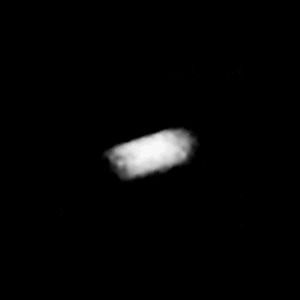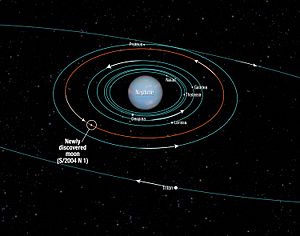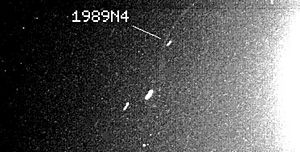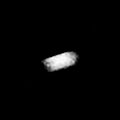Galatea (moon) facts for kids

Galatea as seen by Voyager 2 (elongation is due to smearing)
|
|
| Discovery | |
|---|---|
| Discovered by | Stephen P. Synnott and Voyager Imaging Team |
| Discovery date | July 1989 |
| Designations | |
| MPC designation | Neptune VI |
|
Named after
|
Γαλάτεια Galateia |
| Adjectives | Galatean |
| Orbital characteristics | |
| Epoch 18 August 1989 | |
| 61 952.57 km | |
| Eccentricity | 0.00022 ± 0.00008 |
| 0.42874431 ± 0.00000001 d | |
| Inclination |
|
| Satellite of | Neptune |
| Physical characteristics | |
| Dimensions | 204×184×144 km (±~10 km) |
|
Mean radius
|
87.4 ± 4.9 km |
| Volume | ~2.8×106km3 |
| Mass | 2.12 ± 0.08 ×1018 kg |
|
Mean density
|
~0.75 g/cm3 (estimate) |
| ~0.018 m/s2 | |
| ~0.056 km/s | |
| synchronous | |
| zero | |
| Albedo | 0.08 |
| Temperature | ~51 K mean (estimate) |
| 21.9 | |
Galatea, also known as Neptune VI, is one of the inner moons of Neptune. It is the fourth moon closest to the giant planet. Scientists discovered Galatea in July 1989 using NASA's Voyager 2 spacecraft.
Galatea is a small moon that does not have a perfect round shape. Instead, it is irregularly shaped, like a potato. It moves around Neptune in the same direction that Neptune spins. Scientists think that Galatea was formed from pieces of Neptune's older moons that broke apart. Galatea does not show any signs of geological changes, meaning it has looked pretty much the same since it formed.
Galatea is known as a shepherd moon. A shepherd moon is a small moon that orbits very close to a planet's rings. These moons help to keep the rings in place or create gaps within them.
Interesting Facts About Galatea
- Galatea gets its name from Galatea, a character from Greek mythology. She was one of the fifty Nereids, who were sea nymphs. In one story, a giant named Polyphemus was in love with her, but she did not love him back.
- Scientists believe Galatea is a "rubble pile." This means it is likely made up of many broken pieces of rock and ice that came together again after Neptune's earlier moons were shattered.
- Galatea's orbit is slowly getting closer to Neptune. This means that one day, it might crash into the planet. If it does, it could break apart and form a new ring system around Neptune.
- Galatea always shows the same side to Neptune, just like Earth's Moon always shows us the same face. This is because Galatea's orbit is tidally locked. A tidally locked moon takes the same amount of time to spin around its own axis as it does to orbit its parent planet.
Images for kids
See also
In Spanish: Galatea (satélite) para niños




